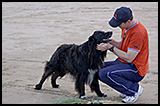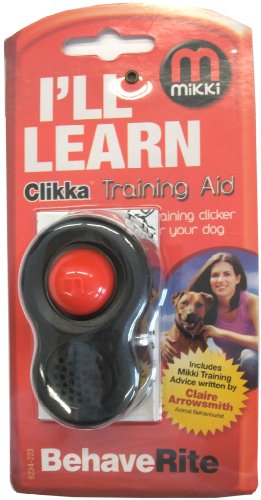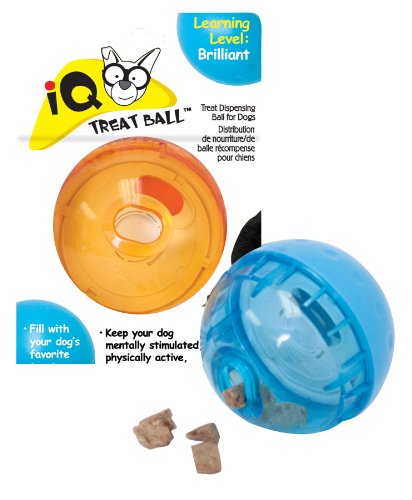
Scenario 1: You’re out for a walk with your young large-breed dog. To use an example, we will say it’s a one year old Rottweiler. Your dog is very active, gets lots of exercise, and loves going for long runs in the woods. Today you are out in the beautiful weather, with nothing on your mind. You are playing fetch with your dog, when all of a sudden something goes wrong. You look one minute and the dog is bouncing up and down through the bush, and the next minute it looks very painful on a rear leg. It looks so painful, in fact, that it won’t even put the leg down at all! You take your dog in to the veterinary clinic as soon as possible, concerned about its leg.
Scenario 2: You’re home with your older dog. Once again, using an example, we will say it’s a nine year old Labrador Retriever, and you begrudgingly admit that your dog may be slightly overweight. OK, knowing the appetite of labs, it probably carries around more than just a few extra pounds. Your dog has become a little bit sore in the back legs over the last year or two. You suspect that it is just getting some arthritis. You’re watching TV, maybe the National Geographic channel or Animal Planet. Your dog hears something at the door and hops off the couch. Suddenly it yelps in pain and starts to limp severely, refusing to put any weight on a back leg. You rush your dog to the veterinary clinic. What happened?
There are quite a few different potential causes for either of these scenarios, but one of the most likely reasons would be a torn cruciate ligament. This is an injury that is very common in human athletes, especially in sports with a lot of knee twisting, like basketball. The knee joint in dogs is very similar to the knee joint in humans. Two bones, the femur and the tibia, are connected at the knee joint. These two bones are held together by quite a few ligaments, which limit the ‘range-of-motion’ of the knee joint. Therefore, because of the ligaments, the knee can only bend in one direction, for walking or running.
Two of these ligaments are called ‘cruciate ligaments’. One keeps the tibia from sliding forward from under the femur, and the other keeps it from sliding backwards. It is usually the anterior cruciate ligament (ACL) that is torn in these cases.
Some dogs are more likely to tear their ACL than other dogs. As seen in the scenarios, it is usually a young, athletic large-breed dog (Newfoundland, St Bernard, Chesapeake Bay Retriever, etc) or an older, overweight dog. In the young dog, the ACL will tear suddenly during exercise. In the older dog, it often already has a partially torn ACL due to the stress of carrying extra weight, so it only takes a minor incident to finally completely tear the weak ACL.
We must keep in mind that any dog, large or small, can tear its ACL at any point in its life. In both of these scenarios the dog’s leg becomes painful, and it may refuse to put its leg down. After a couple of days it may start to limp and put more weight on the leg (it will appear to get better) but in fact the knee is still slightly painful. So you take it to the veterinary clinic.
Your veterinarian will probably not have a very hard time diagnosing this problem. Often they will sedate the dog, to keep it from moving around or tensing up as the vet examines the injured leg. Your vet will perform a ‘drawer test’ and will possibly take some x-rays or run other tests to rule out problems other than an ACL tear. The drawer test determines if the tibia will slide forward from under the femur. If the tibia slides forward, it is very likely that the dog has an ACL tear.
What now, the majority of dogs will require surgery. As long as the dog is not left limping for months before surgery, the surgery usually has a very high success rate. If the surgery is not done, the dog will very quickly get severe arthritis in that leg, because without a properly functioning ACL, the leg is not stable and the knee will become permanently damaged. Some veterinarians have the skill and interest to do ACL surgeries, but many vets refer these dogs to a specialist centre to have the surgery done by a board-certified surgeon.
There are a few different surgeries that can be done to correct this problem. Two of the surgeries are the most common- the extracapsular wire and tibial-plateau leveling osteotomy. The extracapsular wire is a wire that is put in the place of the ACL. It is attached outside of the joint capsule (hence, extracapsular) and supports the knee, the exact same way that the ACL did, until the knee is strong enough to support itself.
Tibial plateau leveling osteotomy (TPLO) is becoming a very common surgery, especially at referral centres. In this surgery, many x-rays are taken to determine the bone angles in the joint. Surgery then changes the angle of the tibia. With the change in angle, the knee joint becomes very stable. This is a more expensive, but very successful, surgery.
What else should we know? For one thing, after surgery your dog will have radical exercise restrictions for about several months. Also, very often (especially in older dogs) the ACL on the other back leg will also tear within a year or two after the first ACL tears. Fixing an ACL tear is not cheap, but on the other hand it is usually successful for long-term health.
If your dog shows pain and is not willing to walk on a leg, you should always take it to the veterinarian. Your vet can then decide if it is a serious injury and requires medication and/or surgery. If your dog shows lingering signs of pain, better safe than sorry. Make sure you get it in to the veterinary clinic to rule out injuries like a torn ACL.
By Ashley O’driscoll – Pets.ca writer
 Basic Learning Theory and Dogs
Basic Learning Theory and Dogs
Basic Learning Theory and Dogs
Basic Learning Theory and Dogs
 Top Seven Dog Treats - A list of the best, most healthy dog treats available
Top Seven Dog Treats
It抯 easy to go to your local pet super
Top Seven Dog Treats - A list of the best, most healthy dog treats available
Top Seven Dog Treats
It抯 easy to go to your local pet super
 Get Started Training Your Dog
IntroductionSo youve got you
Get Started Training Your Dog
IntroductionSo youve got you
 The Five Most Common Dog Diseases including Ringworm and Mange
Bone Problems in a Dog
Credit: Wikime
The Five Most Common Dog Diseases including Ringworm and Mange
Bone Problems in a Dog
Credit: Wikime
 Learn How to Tell if Your Dog or Cat is Obese and in Poor Health
Is your Dog Healthy?Dog and
Learn How to Tell if Your Dog or Cat is Obese and in Poor Health
Is your Dog Healthy?Dog and
Copyright © 2005-2016 Pet Information All Rights Reserved
Contact us: www162date@outlook.com